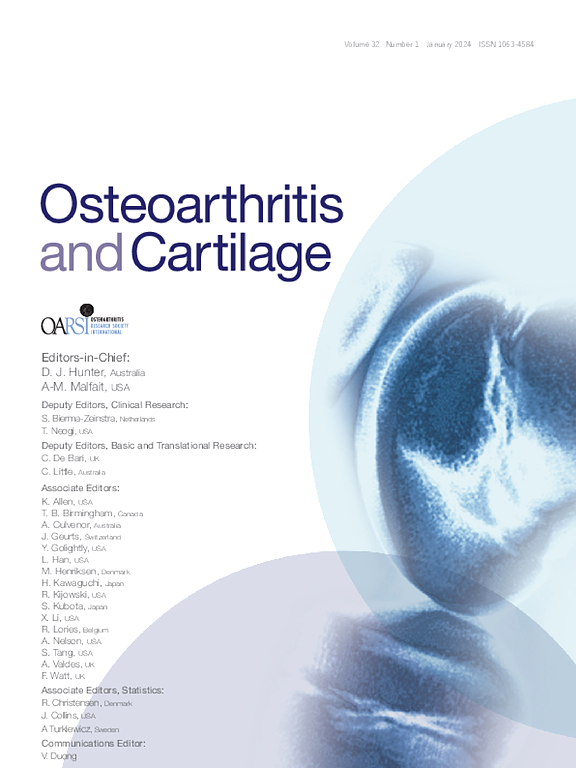Structural knee MRI findings are already frequent in a general population-based birth cohort at 33 years of age
IF 7.2
2区 医学
Q1 ORTHOPEDICS
引用次数: 0
Abstract
Objective
To evaluate the incidence and severity of knee magnetic resonance imaging (MRI) findings and their associated lifestyle and health factors in a relatively healthy subset of a general population-based birth cohort.
Design
The study population (n = 288, 61.1% females, mean age 33.7 years) is a subpopulation of the Northern Finland Birth Cohort 1986 on whom a thorough clinical evaluation, laboratory analyses and knee MRI were conducted at 33 years of age. Knee MRI data was graded using the MRI Osteoarthritis Knee Score system. Descriptive statistics and multivariable regression models were used for data analysis.
Results
Subjects were mostly asymptomatic. Detected articular cartilage lesions were mostly small and identified in 56.2% (n = 162) of patellofemoral and 25.3% (n = 63) of tibiofemoral joints. Full-thickness cartilage lesions and bone marrow lesions were mostly located in the patellofemoral joint. Osteophytes, mostly small or doubtful, were detected in 51.7% (n = 146) of patellofemoral and 17.4% (n = 41) of tibiofemoral joints. In finding-specific regression analyses, higher body mass index (BMI) was most frequently associated with knee MRI findings.
Conclusions
In this relatively young and asymptomatic population, subtle knee MRI findings were already frequent, especially in the patellofemoral joint. Of analyzed background and clinical parameters, higher BMI was most frequently associated with MRI findings. Based on these results, longitudinal studies are warranted to further identify risk factors and proportions of progressing MRI findings.
膝关节结构MRI的发现在33岁的出生队列中已经很常见。
设计研究对象(n = 288,61.1% 为女性,平均年龄 33.7 岁)是 1986 年北芬兰出生队列(NFBC1986)中的一个子群,他们在 33 岁时接受了全面的临床评估、实验室分析和膝关节 MRI 检查。膝关节核磁共振成像数据采用核磁共振成像膝关节骨关节炎评分(MOAKS)系统进行分级。数据分析采用了描述性统计和多变量回归模型。检测到的关节软骨病变大多较小,在髌股关节和胫股关节中分别发现了 56.2% (n = 162)和 25.3% (n = 63)的病变。全厚度软骨病变和骨髓病变主要位于髌股关节。在51.7%的髌股关节和17.4%的胫股关节(分别为146个和41个)中发现了骨质增生,多数为小骨质或可疑骨质。结论 在这一相对年轻且无症状的人群中,膝关节微妙的 MRI 发现已经很常见,尤其是在髌股关节。在分析的背景和临床参数中,较高的体重指数(BMI)最常与核磁共振成像结果相关。基于这些结果,有必要进行纵向研究,以进一步确定风险因素和磁共振成像结果进展的比例。
本文章由计算机程序翻译,如有差异,请以英文原文为准。
求助全文
约1分钟内获得全文
求助全文
来源期刊

Osteoarthritis and Cartilage
医学-风湿病学
CiteScore
11.70
自引率
7.10%
发文量
802
审稿时长
52 days
期刊介绍:
Osteoarthritis and Cartilage is the official journal of the Osteoarthritis Research Society International.
It is an international, multidisciplinary journal that disseminates information for the many kinds of specialists and practitioners concerned with osteoarthritis.
 求助内容:
求助内容: 应助结果提醒方式:
应助结果提醒方式:


